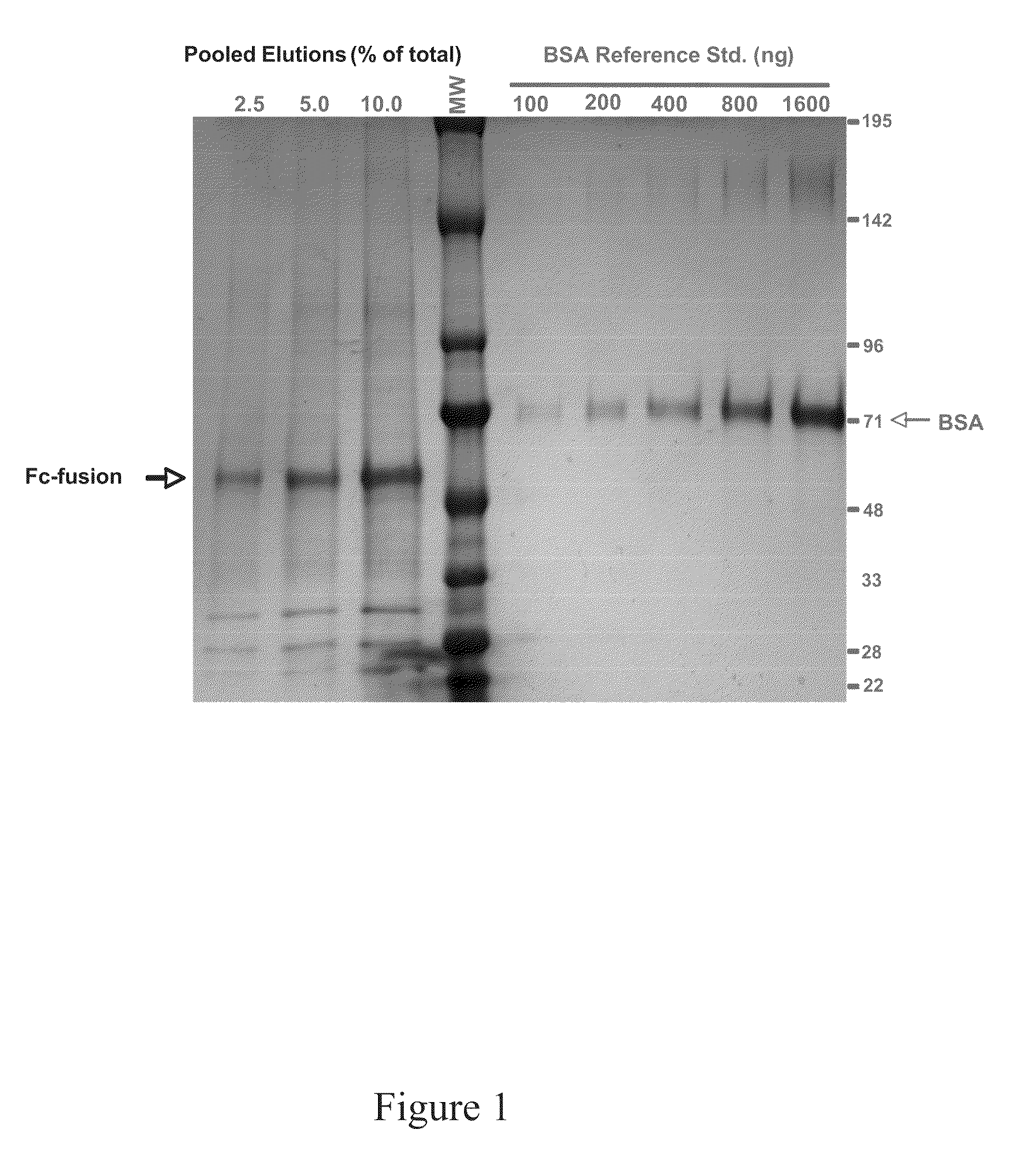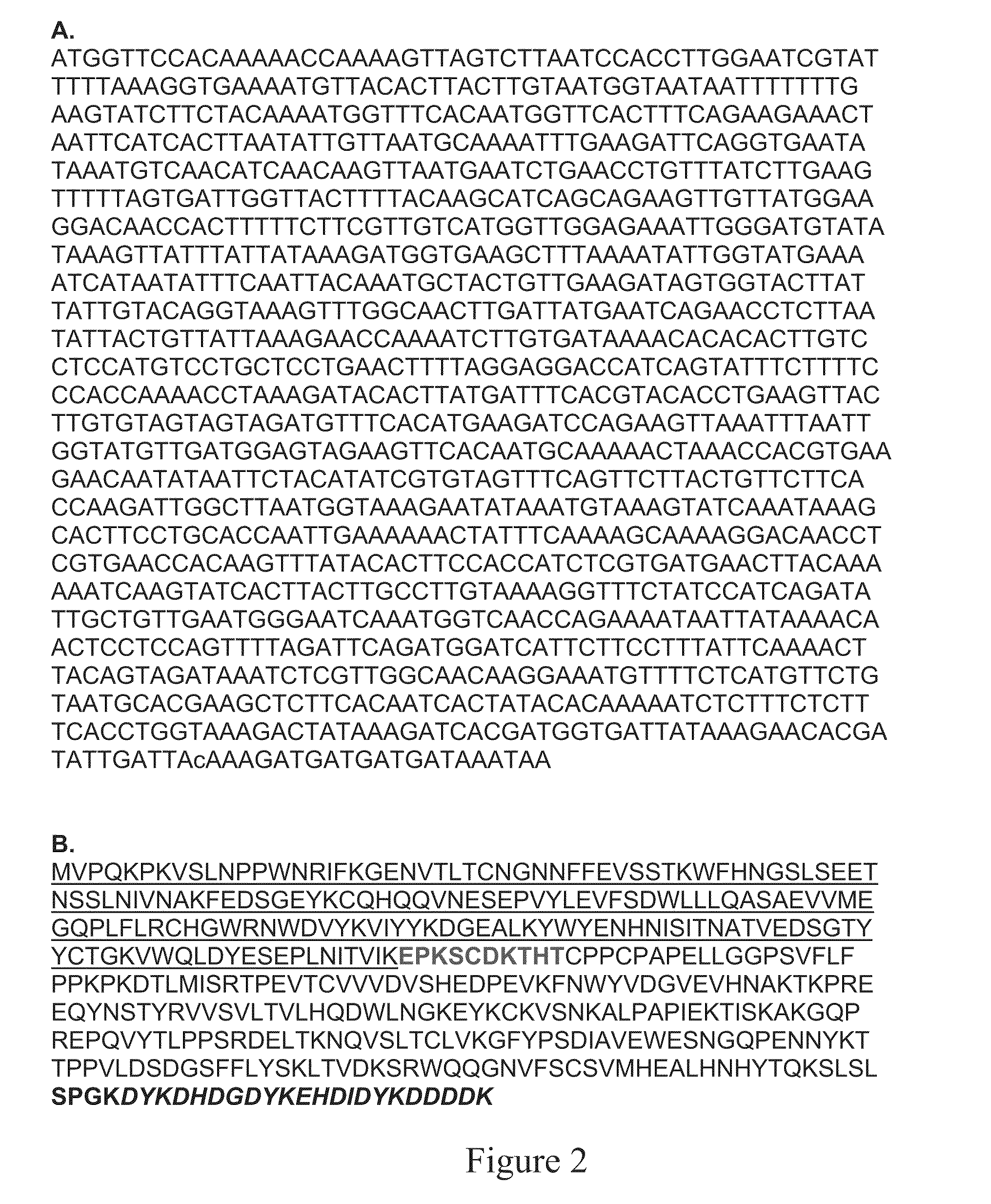Production of fc-fusion polypeptides in eukaryotic algae
a technology of eukaryotic algae and polypeptides, which is applied in the field of fc-fusion constructs, can solve the problems of complex molecules, inability to efficiently express and accumulate biologically active eukaryotic proteins in their native state, and inability to achieve functional conformations at reasonable cost in cell-based biomanufacturing systems
- Summary
- Abstract
- Description
- Claims
- Application Information
AI Technical Summary
Benefits of technology
Problems solved by technology
Method used
Image
Examples
example 1
Expression of Fc-Fusion Proteins
[0159]A mammalian soluble receptor was fused to the hinge, CH2 and CH3 domains of a human IgG1 molecule. The exact nature of the amino acid sequence at the receptor-Fc junction is somewhat important, as many workers have observed that not all native sequences will lead to expression / accumulation of the molecule. Often times, the precise amino acid sequence in this region must be optimized to obtain a molecule which is stable and soluble, in vivo. This construct, codon optimized for expression in the C. reinhardtii chloroplast, was then cloned downstream of the strong 16sG promoter / atpA 5′ UTR (16sG / atpA) or the psbA promoter / 5′ UTR (psbA) for expression in C. reinhardtii chloroplasts. 16sG / atpA driven cassettes were introduced into the p321 vector for integration in the inverted repeat region of the C. reinhardtii chloroplast genome, while psbA driven cassettes were introduced into the Chl B region in a construct which completely ablates this non-esse...
example 2
Receptor-Fc Fusions
[0163]a. IL-17 Receptor-Fc Fusions
[0164]Secreted by CD4 T cells, IL-17 is a cytokine that shows markedly elevated levels in the synovial fluid of patients with rheumatoid arthritis. IL-17 is clearly involved in the inflammatory pathway in ways similar to tumor necrosis factor (TNF). Controlling IL-17 levels through its sequestration by a soluble receptor-Fc fusion, is one approach to mitigating its pro-inflammatory properties. Possible indications where such molecules might show efficacy are RA, Crohn's disease and Irritable Bowel Syndrome.
[0165]The amino acids delimiting the extracellular domain of IL-17 receptor may be determined from the GenBank database, for example, for Gen Bank Acc. No. Q9NRM6, the extracellular domain comprises amino acids 18-292. A chloroplast biased nucleotide sequence is generated which encodes extracellular domain (see Franklin et al. Plant J (2002) 30:733-744, Mayfield et al., Proc Natl Acad Sci USA (2003) 100:438-442, Mayfield et al.,...
example 3
Non-Receptor-Fc Fusions
[0185]a. Factor-VII Fc Fusion (ICON)
[0186]Factor-VII is the natural ligand for the transmembrane receptor known as tissue factor. Tissue factor is selectively expressed on proliferating endothelial cells of the tumor vasculature and not in normal tissues. Age-related macular degeneration (AMD) is the cause of irreversible blindness in elderly population. In order to reduce the rate of visual loss in patients with AMD, minimizing sub-retinal choroidal neo-vascularization is of paramount importance. The Factor-VII domain in the Fc fusion binds with high affinity and specificity to tissue factor, while the aglycosylated Fc effector domain, recruits natural killer cells initiating a powerful cytolytic response against cells expressing tissue factor.
[0187]The amino acid sequence for Factor-VII is well known in the art, and may be obtained from the GenBank database, for example, Gen Bank Acc. No. AAA51983. A chloroplast biased nucleotide sequence is generated which ...
PUM
| Property | Measurement | Unit |
|---|---|---|
| Mass | aaaaa | aaaaa |
| Fraction | aaaaa | aaaaa |
| Fraction | aaaaa | aaaaa |
Abstract
Description
Claims
Application Information
 Login to View More
Login to View More - R&D
- Intellectual Property
- Life Sciences
- Materials
- Tech Scout
- Unparalleled Data Quality
- Higher Quality Content
- 60% Fewer Hallucinations
Browse by: Latest US Patents, China's latest patents, Technical Efficacy Thesaurus, Application Domain, Technology Topic, Popular Technical Reports.
© 2025 PatSnap. All rights reserved.Legal|Privacy policy|Modern Slavery Act Transparency Statement|Sitemap|About US| Contact US: help@patsnap.com



